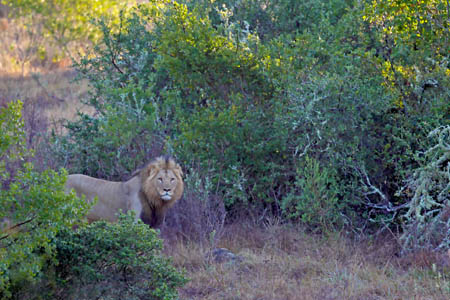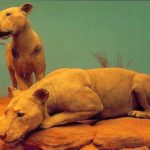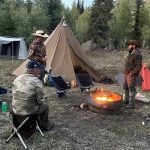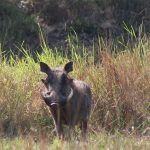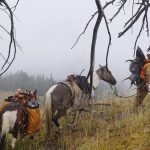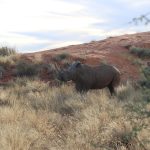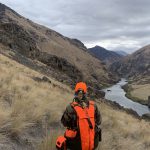Increase your awareness of your surroundings by consciously training yourself to see what you’re missing.
Elspeth Huxley, author of The Flame Trees of Thika and other worthy books on Africa, once recalled a family picnic in Kenya, an hour of eating and children playing in an open area bordered by a circle of brush. Only after photos of the outing were developed did the picnickers see two lions hunkered rather plainly in the thicket, watching from no more than thirty yards away. Huxley, who grew up in rural Kenya, thought this a good lesson on the need for more rigorous awareness, especially in Africa, where potential dangers can abound.
Psychologists call not seeing what’s in front of us “inattentional blindness,” and warn that it is more common than most people realize. Sometimes the extent of perceptive failure can almost defy belief, as in the famous Gorilla Experiment at Harvard. Here student subjects were divided into two teams—white shirts and black shirts—and told to toss two orange basketballs back and forth. Forty-five seconds into the game, a woman in full gorilla costume walks directly through the scene. Amazingly, 56 percent of the players, intent on their basketball tosses, failed to see the gorilla. In another version, the gorilla comes in, pounds her chest and walks off, in view for a full nine seconds. Yet—again, hard to believe—only 50 percent of the players noticed the intruding ape.
The experiment is a startling example of how blind to our environment we can be at times, especially when we are focused on specific tasks, or when we have a lapse in general attentiveness. Perceptual limitation tends to worsen even more during emergencies, when narrowed vision is a common reaction. We sometimes literally cannot see (or hear) anything other than the immediate threat or focus of our attention. Countless people have died or become gravely injured when a simple and easy escape from danger was obvious to onlookers but went unnoticed by the oblivious victims.
This can occur in non-emergency situations, as well. A common problem for hunters is tunnel vision—being so focused on a game animal or a track line that we can’t or don’t see anything else but the target of our desire. My bear-biologist friends often complain about hunters who simply don’t see obvious tracks, rubs, scats, and other signs of nearby grizzlies because they are so locked in and focused on the elk, deer, or moose they are after. Worse still are the (thankfully uncommon) hunters who are so hyped for game they “see” an antlered animal where one doesn’t exist. Horses, people, and even vehicles have been shot by hunters who swore they shooting at a buck or bull. Some of these cases defy plausibility, yet they do occur.
The antidote to all of these perceptual failures, and a good way to become both a better hunter and a more effective survivor, is to first become aware of your awareness by making it a subject of mindful concern. How well and fully are you paying attention in a given moment? How well have you been paying attention in the last few minutes or quarter-hour? Asking yourself these questions on a periodic basis can be educational, and can also help you tune back in to the present with renewed and sharpened clarity.
Situational awareness. Military, law enforcement, and an increasing number of wilderness survival schools now emphasize this concept as primary and essential. Situational awareness is a conscious taking in and evaluating of the immediate environment, with an eye both for what’s actually there, and also what might ensue, good or bad. Some people assume that such a view must entail a negative or even paranoiac view of life, but that’s a misunderstanding. The idea is to do what is usually termed a “situation scan” or “environmental survey” that (again, consciously and intentionally) looks at more than just the central claim on ordinary attention. One simple technique is the survival sweep, a usually brief but focused scanning from side to side, bottom to top, while looking for potential trouble, or ways out of trouble should something go wrong. Do this periodically as you move along, and especially when entering a new or changed environment, whether it is a narrow, rocky canyon or a jetliner taking you to Africa. As you get on the jet (or into any confined space, for that matter) scan for the nearest exit or way out in case of an emergency.
Inferential awareness. Last year while hunting elk in remote western Montana backcountry I suddenly caught a whiff of something unpleasant. I was on a narrow game trail, approaching a stand of thick timber, with a slight breeze in my face. The smell deepened and intensified into the heavy stink of carrion. I didn’t investigate, but turned around and quickly got out of there. This was prime grizzly country, and I wasn’t about to risk walking into a griz bedded down atop a cached elk or mule deer. I hadn’t seen much bear sign in the last two days, but there was no point in taking a risk. The smell was enough of a warning in that situation. Similarly, the alarm calls of a gray jay or Clark’s nutcracker, or raven, or the chattering hysteria of a spooked pine squirrel, can tell the aware hunter that something is up. Sometimes you can follow the alarm noises to track whatever is on the move—maybe a bear or a mountain lion or an elk, or another hunter. Other times, the lack or sudden cessation of a sound— birds stop chirping, frogs quit croaking—can be of equal inferential value.
Awareness tips and tricks. One key to “seeing” better outdoors (more fully, with less inattentional blindness) is to recognize visual patterns such as the predominant verticality of a forest or swath of tall grass and then scan and inspect for anything that breaks or alters that pattern, which in this example would mean anything approximately horizontal. In a mostly still habitat, look for motion, however small. Many times I’ve spotted a bedded animal because a slight ear flicker gave it away. Tail flicks and twitches are another common giveaway. It’s also helpful to note color and shade contrasts. A glistening black eyeball might be all you see (at first) of a bear in the brush or a snake blending with fallen leaves on a trail. Here’s a counterintuitive tactic that can make it easier to pick up motion, however small, within a larger setting: Relax your eyes and let them unfocus slightly so that you are taking in the larger view as though through a soft wide-angle lens. By not focusing on any particular area, your eyes are more able to pick up movement in the entire field of vision. Once movement is detected, you can zero in on it with renewed focus. Most people don’t use their peripheral vision to its full ability and range. For instance, in dim light or at night it’s often easier to make out objects by shifting from a straight-on stare to peripheral scanning.
In many advanced martial arts systems a standard posture for multiple-attacker encounters (with attackers coming from both sides) is standing sideways to the assailants while looking slightly downward and ahead, maintaining soft, open focus (that is, not focusing on the ground or any other object). This expands your peripheral-vision range, letting you pick up any motion that occurs on either side, in front and well behind (though not directly in back of) your position. In effect it allows you to see in several directions at once. The same technique can be used in many danger, emergency, and survival situations and is worth experimenting with and practicing until you can use it at will.
Awareness training: The best survival schools these days include both conceptual and practical teaching in “awareness expansion” and ability. Most hunters probably aren’t going to put themselves through formal training, but there are a number of fairly simple tips that can help anyone develop better awareness. Step one is to become aware of your awareness. This means also becoming aware of your unaware lapses and tendencies. It’s very easy for the modern technologized human mind to drop into daydreams, frettings, distractions, and other semi-trancelike states. Catching yourself and shifting back into awareness mode is an essential training exercise. Another is consciously observing, which means timed periods of looking at small, even minute details that would be overlooked in normal unaware mode. An aid to this exercise is framing, wherein you impose an artificial (or actual) limiting frame on a section of reality and then examine it with slow and deliberate care, noticing things usually neglected such as textures, shade contrasts, color variations, patterns within patterns, and so on. Also try changing points-of-view periodically. Outdoors, we tend to mainly view the world from standing head-height, so alterations in physical perspective, such as getting lower and closer to the ground, or changing angles relative to the light source, can be surprisingly revealing (especially when tracking or trailing game, for instance), allowing you to see important details that might otherwise be missed.

